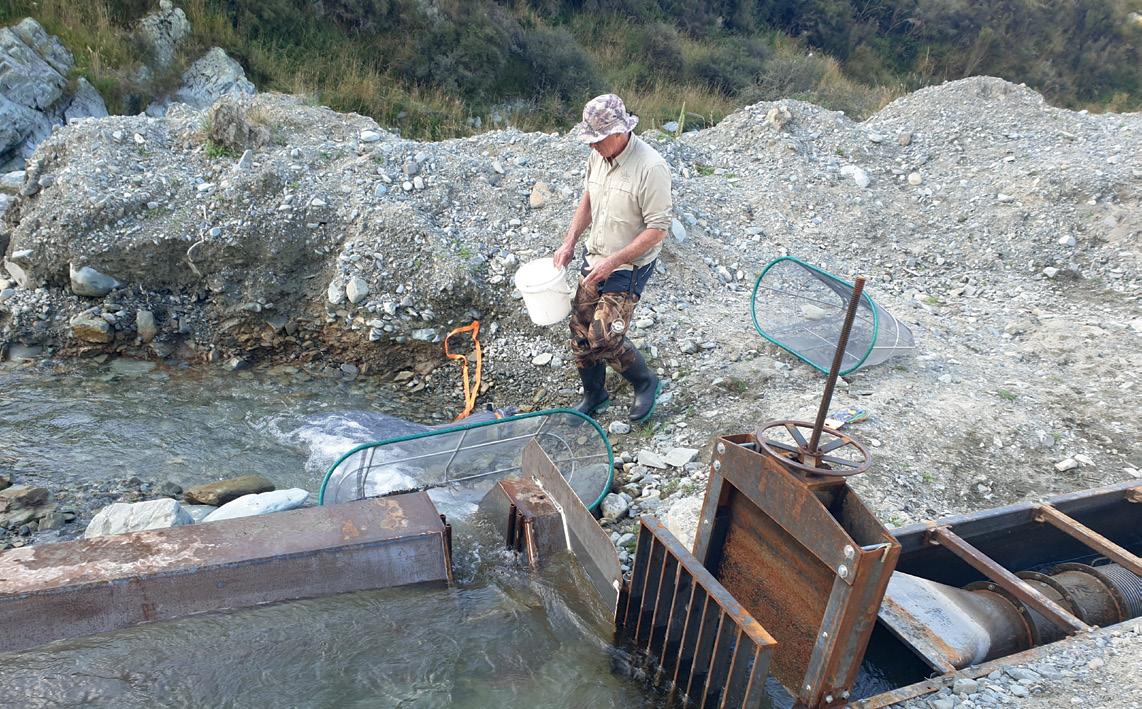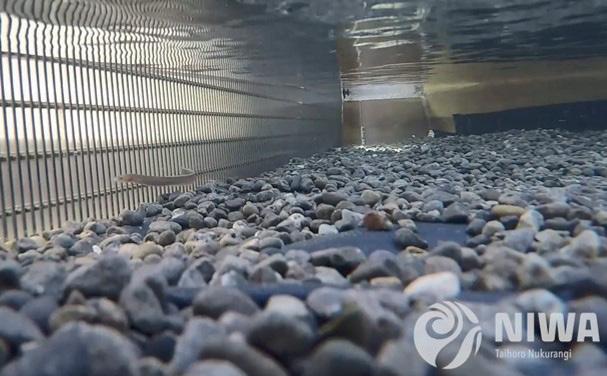
4 minute read
Adoption of Good Practice Fish Screening Project Summary Report
SUSTAINABLE FARMING FUND (SFF) 405972
Project Summary
Advertisement
Water intake structures are used throughout New Zealand to supply water used for irrigation, generation of hydro-electricity, domestic water supply, and industrial needs. If surface water intake structures are not properly screened, and/ or have screens that are not correctly designed and/or maintained, they can unintentionally damage or remove fish from rivers through impingement and entrainment. The fundamental purpose of a fish screen facility is to ensure safe passage for all fishes around the facility within or back to the source waterway.
Until 2019 there had been limited research addressing the New Zealand-specific knowledge gaps identified in the ‘Fish screening: good practice guidelines for Canterbury’ (NIWA, Jamieson et al. 2007, and hereafter called the NIWA 2007 Guidelines). Difficulties remained for abstractors, designers, installers, and operators in understanding and seeking to meet the criteria or relevant local planning legislation requirements.
In 2019 the Ministry for Primary Industries, through its Sustainable Food and Fibre Futures programme, co-funded a research project titled Adoption of Good Practice Fish Screening. The project was administered by Irrigation New Zealand on behalf of the New Zealand Fish Screen Working Group. It aimed to fill key knowledge gaps identified in the NIWA 2007 Guidelines and to support good practice by developing guidance and demonstrating examples of fish screen facilities that are considered effective in achieving the overall outcome of protecting fish and fisheries.
1. All key reports and project outcomes mentioned in this report can be found on the IrrigationNZ fish screens webpage irrigationnz.co.nz/KnowledgeResources/FishScreens
Key Project Deliverables
• Reviewing regional water intake issues and requirements in New Zealand.
• Laboratory trials to fill knowledge gaps and confirm design criteria that protect fishes from impingement, entrainment, and damage.
• Field trials to assess the effectiveness of fish screen designs compared to the seven key criteria in the NIWA 2007 Guidelines and those adopted into the Canterbury Land and Water Plan Schedule 2.
• Production of an online Fish Screen Facility Guidance Tool
• Developing a national policy and practice guidance document.
• Workshopping example sites through the Fish Screen Facility Guidance Tool to provide demonstration examples that would be considered effective.
• Production of a guidance document “Toward National Guidance for Fish Screen Facilities to Ensure Safe Passage for Freshwater Fishes” to supplement the NIWA 2007 Guidelines.
• Training for designers, abstractors, manufacturers, regulators, and consultants working with fish screens.
Progress Highlights
The NIWA 2007 Guidelines provided seven design criteria for effective and efficient fish screening. This project has confirmed the NIWA 2007 seven criteria were key for successful fish screening facility design that prevents entrainment and impingement of fish. Additionally it found design and connection of a suitable bypass, the correct fitting, maintenance, and operation of screens, and consideration of upstream fish passage needs were often overlooked and needed consideration, i.e. an eighth criterion. A balanced design approach for water intakes is needed that gives consideration to all criteria (Table 1) and considers each site solution as a package. The project provides improved explanations of the criteria.
Table 1: Key criteria required for an efficient and effective water intake and fish screen.
Factor Description
Intake location The water intake is located to minimise exposure of fish to the screen and minimises the length of stream channel affected while providing the best possible conditions for the other criteria.
Throughscreen velocity
Sweep velocity
Fish bypass at water intake
The water velocity through the fish screen is slow enough to allow fish to escape entrainment or impingement

The water velocity past the fish screen is sufficient to sweep fish past the intake promptly and into the bypass
A suitable bypass (where needed) is provided so that fish are taken away from the intake and back into the active waterway
Conclusions
Fish bypass design for connectivity
Gap openings in intake structure
Operations and maintenance
There is connectivity between any constructed bypass and somewhere safe, usually the mainstem of the waterway
Screening material and other joins/edges have openings small enough to exclude fish, and a smooth surface to prevent any damage to fish
The water intake needs be kept operating to a consistent standard with appropriate operation and maintenance, this includes consideration of debris management
There is no simple recipe for an effective fish screen facility that applies across all situations. The physical conditions (e.g. gradient and flow) and biological conditions (i.e. fish species and life stages present) at every intake are different. The NIWA 2007 Guidelines together with the new guidance document can help identify issues and considerations, and provide good reference information for designers, infrastructure owners, and regulators. However, because each case is different, it is not straightforward to go from that fundamental knowledge to a practical solution.
Upstream fish passage
EITHER the water intake and fish screen does not impede upstream passage of migratory fish species during all flows and does not increase the risk of predation OR the bypass outlet impedes fish passage into the bypass and keeps fish in the natural waterway but fish moving downstream through the bypass are not harmed while returning to the waterway
The project identified areas that require New Zealandspecific knowledge, ideally through additional research, to lead to better outcomes in fish screen facility design and management:
• Improving knowledge of water velocities near screens and the effects of turbulence on fish survival to improve fish screen facility designs.
• Understanding fish behaviour at bypasses to improve the overall effectiveness of these facilities.
• Establishing better links within the regulatory processes, including meeting the needs of mana whenua, to improve certainty.
• Promoting innovation and problem-solving in the design and planning processes to allow additional refinement of the Fish Screen Facility Guidance Tool.
There are usually several fish screen facility designs that could satisfy the key criteria at a site. Selecting from these alternative designs must take into consideration site-specific characteristics, including existing infrastructure, biological considerations, hydraulic functioning, geographical constraints, and client preferences. All fish screen facility designs require engineering and biological input, including assessment of site-specific fishery information.
The Fish Screen Facility Guidance Tool provides a method to document and support selection of applicant/consultant preferred designs that could then be developed for a conceptual design. Designs that are likely to meet all key criteria have been workshopped for a variety of different intake locations to provide some examples.
For further information on the fish screen project, including access to key reports, the Fish Screen Facility Guidance Tool and the latest guidance document, visit www.irrigationnz.co.nz/KnowledgeResources/FishScreens

